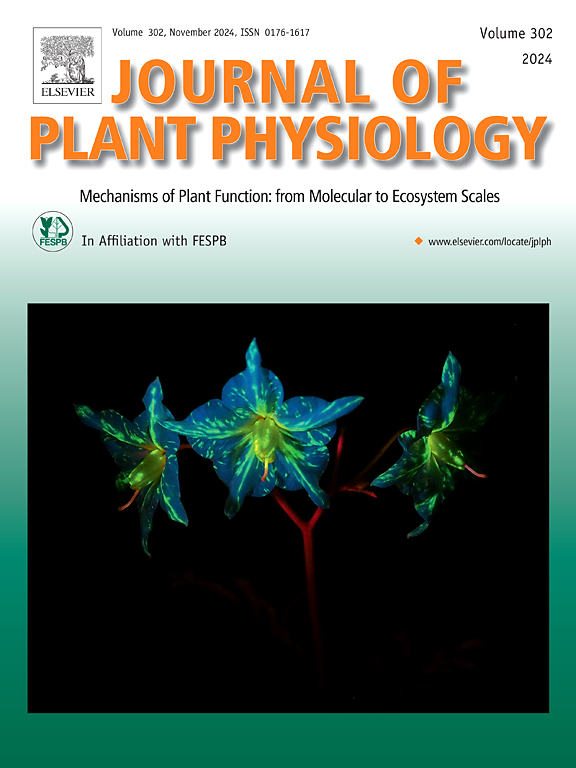Pollen tube-expressed RUPO forms a complex with OsMTD2 and OsRALF17 and OsRALF19 peptides in rice (Oryza sativa)
IF 4
3区 生物学
Q1 PLANT SCIENCES
引用次数: 0
Abstract
Pollen tubes are crucial for angiosperm plants, as they deliver sperm gametes for the essential process of double fertilization. Understanding the molecular mechanisms behind pollen tube germination and growth is critical; however, these processes remain partially elucidated in monocot cereal crops. Rapid Alkalinization Factor (RALF), a small peptide of about 5 kDa, binds to the CrRLK1L receptor and plays a role in various plant physiological processes, including reproduction and tip growth. Recently, we reported that OsRALF17 and OsRALF19 binds to the OsMTD2, pollen specific CrRLK1L member, and regulates pollen tube growth. In this study, we demonstrate that Ruptured Pollen tube (RUPO), another CrRLK1L member, is also a putative receptor for OsRALF17 and OsRALF19, and propose the formation of a receptor complex with OsMTD2. In tobacco epidermal cells, OsMTD2 and RUPO were co-localized at both the plasma membrane (PM) and the nuclear membrane. Additionally, we generated a RUPO-tagged line driven by its native promoter to visualize subcellular localization during pollen tube growth. RUPO localizes a tip-enriched distribution, with intense fluorescence at the tip's PM and cytoplasm in pollen tube. Upon treatment with synthetic OsRALF17M and OsRALF19M peptides, a reduction in the signal near the PM was observed, suggesting a potential response to these peptides. Our data support the role of RUPO as a candidate receptor for OsRALF17 and OsRALF19 in rice pollen tubes, thereby suggesting a novel mechanism for these RALFs in regulating pollen tube function. Additionally, we observed a significant delay in pollen tube burst time upon treatment with synthetic OsRALF17M and synthetic OsRALF19M. We propose that investigating this phenomenon may provide further insights into the specific signaling pathways mediated by these RALFs.
在水稻(Oryza sativa)中,花粉管表达的RUPO与OsMTD2、OsRALF17和OsRALF19肽形成复合物。
花粉管对被子植物至关重要,因为它们为双重受精的基本过程提供精子配子。了解花粉管萌发和生长背后的分子机制至关重要;然而,这些过程在单子叶谷类作物中仍有部分阐明。快速碱化因子(RALF)是一种约5kda的小肽,与CrRLK1L受体结合,在植物的多种生理过程中发挥作用,包括生殖和尖端生长。最近,我们报道了OsRALF17和OsRALF19与花粉特异性CrRLK1L成员OsMTD2结合,调控花粉管生长。在本研究中,我们证明了另一个CrRLK1L成员破裂花粉管(RUPO)也是OsRALF17和OsRALF19的假定受体,并提出了与OsMTD2形成受体复合物。在烟草表皮细胞中,OsMTD2和RUPO同时定位于质膜和核膜。此外,我们生成了一个由其原生启动子驱动的rupo标记系,以可视化花粉管生长过程中的亚细胞定位。RUPO定位于一个尖端富集的分布,在花粉管的尖端PM和细胞质上有强烈的荧光。在用合成的OsRALF17M和OsRALF19M肽处理后,观察到PM附近的信号减少,表明对这些肽有潜在的反应。我们的数据支持RUPO作为水稻花粉管中OsRALF17和OsRALF19的候选受体的作用,从而提示了这些ralf调节花粉管功能的新机制。此外,我们观察到合成OsRALF17M和合成OsRALF19M处理后花粉管破裂时间显著延迟。我们认为,研究这一现象可能会进一步深入了解由这些ralf介导的特定信号通路。
本文章由计算机程序翻译,如有差异,请以英文原文为准。
求助全文
约1分钟内获得全文
求助全文
来源期刊

Journal of plant physiology
生物-植物科学
CiteScore
7.20
自引率
4.70%
发文量
196
审稿时长
32 days
期刊介绍:
The Journal of Plant Physiology is a broad-spectrum journal that welcomes high-quality submissions in all major areas of plant physiology, including plant biochemistry, functional biotechnology, computational and synthetic plant biology, growth and development, photosynthesis and respiration, transport and translocation, plant-microbe interactions, biotic and abiotic stress. Studies are welcome at all levels of integration ranging from molecules and cells to organisms and their environments and are expected to use state-of-the-art methodologies. Pure gene expression studies are not within the focus of our journal. To be considered for publication, papers must significantly contribute to the mechanistic understanding of physiological processes, and not be merely descriptive, or confirmatory of previous results. We encourage the submission of papers that explore the physiology of non-model as well as accepted model species and those that bridge basic and applied research. For instance, studies on agricultural plants that show new physiological mechanisms to improve agricultural efficiency are welcome. Studies performed under uncontrolled situations (e.g. field conditions) not providing mechanistic insight will not be considered for publication.
The Journal of Plant Physiology publishes several types of articles: Original Research Articles, Reviews, Perspectives Articles, and Short Communications. Reviews and Perspectives will be solicited by the Editors; unsolicited reviews are also welcome but only from authors with a strong track record in the field of the review. Original research papers comprise the majority of published contributions.
 求助内容:
求助内容: 应助结果提醒方式:
应助结果提醒方式:


